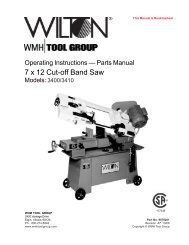Caution: This document contains mixed page sizes ... - Igor Chudov
Caution: This document contains mixed page sizes ... - Igor Chudov
Caution: This document contains mixed page sizes ... - Igor Chudov
Create successful ePaper yourself
Turn your PDF publications into a flip-book with our unique Google optimized e-Paper software.
*<br />
PART II<br />
TROUBLESHOOTING<br />
PROCEDURES<br />
(YD GENERATORS USING UR REGULATOR)<br />
The information in this section is for generators used<br />
on 25DTA/MDTA series sets and the 30kW PTO and<br />
SKsets. Information is divided into Flow Charts, A, B,<br />
C, D and E as follows:<br />
A. NO AC OUTPUT VOLTAGE AT RATED ENGINE<br />
RPM.<br />
B. UNSTABLE OUTPUT VOLTAGE, ENGINE<br />
SPEED STABLE 1800 RPM.<br />
C. OUTPUT VOLTAGE TOO HIGH OR LOW.<br />
D. EXCITER FIELD BREAKER TRIPS.<br />
E. UNBALANCED GENERATOR OUTPUT VOLT-<br />
' AGE.<br />
To troubleshoot a problem, start at upper-left corner<br />
of the chart related to problem, and answer all ques-<br />
tions either YES or NO. Follow the chart until the<br />
problem is found, performing referenced Adjustment<br />
and Test procedures following the Flow Charts.<br />
Referenced components in the Flow Charts and<br />
Adjustment and Test procedures can be found on the<br />
electrical schematic Figure 20, and on assembly<br />
drawings and wiring diagrams on <strong>page</strong>s 32-34.<br />
GENERATOR OPERATION<br />
The basic operation of the generator and AC controls<br />
involves thestator, voltage regulator, exciter field and<br />
armature, afull wave bridge rectifier, and the genera-<br />
tor rotor, Figure 20. Residual magnetism in the gen-<br />
erator rotor and a permanent magnet embedded in<br />
one exciter field pole begin the voltage build-up pro-<br />
cess as the generator set starts running. Single-<br />
phase AC voltage, taken from the stator windings, is<br />
fed to the voltage regulator as a reference voltage for<br />
maintaining the generator output voltage. The AC<br />
reference voltage is converted to DC by a silicon<br />
controlled rectifier (SCR) bridge and fed into the<br />
exciter field windings. The exciter armature produces<br />
three-phase AC.voltage that is converted to DC by the<br />
rotating rectifier assembly. The resultant DC voltage<br />
excites the generator rotor winding to produce the<br />
stator output voltage for the AC load.<br />
The SCR bridge is encapsulated in a hermetically<br />
sealed block. Therefore, if any diode or silicon con-<br />
trolled rectifier fails, the entire bridge has to be<br />
replaced.<br />
ASSEMBLY I<br />
FIGURE 20. ELECTRICAL SCHEMATIC, YD GENERATOR WITH TYPE UR REGULATOR<br />
21<br />
I<br />
ES1067
















